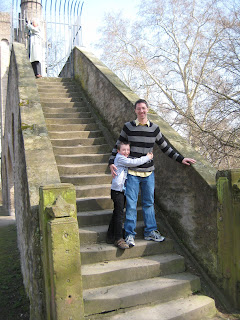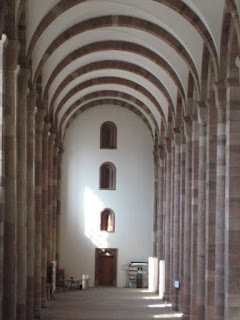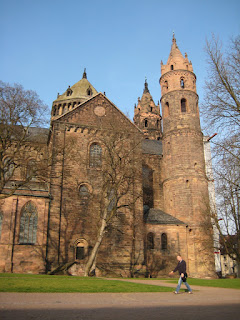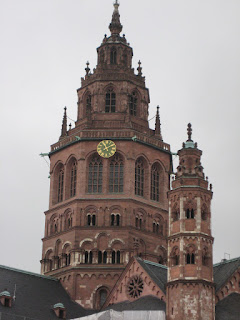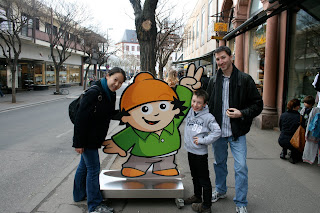Bright and early Monday monring, we left for Mainz, our first destination in the Rhine Valley. Mainz, the capitol of the state Rhineland-Palatinate, is a rather metropolitan city with a large university. After a traditional Herth breakfast of musli (kind of a fruit "oatmeal"), we picked up Benjamin and headed down the autobahn. Mainz is about an hour's drive from where Biebelsheim.

We parked a bit away from the city center, so we had a short walk to get to the main attraction of the city -- the Kaiserdom. On the way we happened to pass a large bookstore, which Jo just couldn't resist (there aren't very good bookstores in Wolfsburg). When Jo gets lured into a bookstore, well, that's just it. In the meantime, the rest of us went to get coffee. Just down the street was a French-themed cafe. They had little mosaics of angel scenes painted all over. Not knowing much of the French language (I can only do so much), I was confused by some of the decor. Why would a nice cafe have baskets of "pain" in their shelving?
Yes, French-speakers, I now know that "pain" is French for "bread". Here's Mike and me not sitting in front of the baskets for pain.

A short while later Jo joined us for coffee, and soon enough we were back on track to see the Kasierdom. This cathedral, along with the cathedrals of Speyer and Worms (scheduled for the next day), is one of the only three Romanesque imperial cathedrals to have survived nearly intact to present day.
The cathedral's basic framework was laid out in 1081, but its oldest parts date back to the 10th century. There are stained glass windows that commemorate its past archbishops, going all the way back to Archbishop Willigis in 975. In medieval times German kings and queens were crowned here.
Although this is a Romanesque cathedral, many of the altars and side chapels inside are actually Gothic in style. It was a bit shocking to us to see such ornamentation inside. As Mike put it, the focus is not so much on worshiping God or telling the story of Jesus, but is instead focused on celebrating and memorializing former archbishops and patrons of the church.
The cloister, or the open space and covered walkways inside cathedrals, was much more simplistic and peaceful.
After the cathedral, we spent some time in Gutenberg Platz, named after the Johannes Gutenberg, inventor of the printing press. There was a museum honoring the city's most famous citizen, but being a Monday it was closed.
The plaza itself was nice and picturesque.
Jo found himself another bookstore, so we hung around and window shopped until it was time to find a place for lunch. We wandered towards the Rhine River in search of a restaurant that struck our fancy. Along the way we came upon this structure.
This is St. Christoph Parish Church, the church that Gutenberg was supposedly baptized in. Dating back to the 9th century, the church was bombed and severely damaged during World War II. It was rebuilt as one of Mainz's war memorials.
The sculptor Heinz Hemrich designed the new buttresses that were meant to represent the city's history.
Gutenberg's statue stands near the church.
Just to the left of the statue was an Italian restaurant with "Cuban flair". We had ourselves a nice lunch and coffee before leisurely heading towards the Altstadt for some more window shopping and random wandering.
Along the way, we posed with some famous German cartoon character in the street.
This photo of the Altstadt is just behind the Dom. You can still see the cathedral in the background.
In our wanderings, we came upon this church squeezed in between a bunch of other random buildings.
When we walked inside, it was like walking into a Disney Princess world. Everything was pastel colored and covered with angels. Don't get me wrong -- it was beautiful! But, wow... I don't think I've ever seen so much pink stone/marble in one place before. It doesn't look it from the outside, but the high frescoed ceiling, and huge marble pillars make the interior seem very spacious.
Our last run-in during our wanderings in Mainz was with a statue of
Till Eulenspiegel -- an infamous trickster in German folklore.

Seeing the statue just reminded me of the fantastic
tone poem of the same name by Richard Strauss (who can forget that horn solo after living in the practice room halls of
humanities for four -- or more -- years?).
After visiting one more bookstore (that actually makes a grand total of four bookstores in one day because I didn't mention one other stop...), we headed back to headquarters in Biebelsheim. All of us were exhausted from the day's excursions.
Our last treat for the day was when Mike and I grabbed a late light dinner with Jo at a lovely restaurant along the Rhine back in Bingen. Jo wanted to treat us to a traditional French/German Alsacian fare called
Flammkuchen. This traditional German "pizza" is made of very, very thin crust and topped with Crème Frâiche, onions, and Speck or bacon. All of this is thrown into an intensely hot oven to be quickly cooked. The dough is so thin that, as Jo put it, it is meant to be ordered one after another and shared so that it doesn't go cold.
This restaurant had two kinds of
Flammkuchen, a traditional one and a vegetarian one. Unfortunately, they were out of Speck when we were there, but the ham that replaced it was still good. We all agreed the traditional Flammkuchen was better --- and so delicious. A perfect way to end the night and prepare for the next day's adventures.



